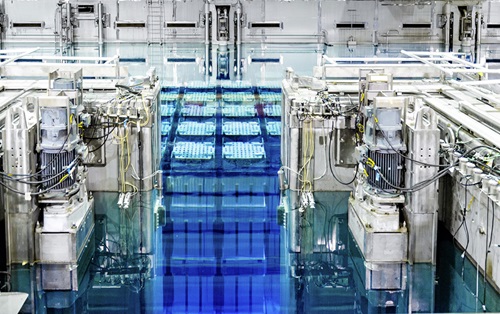
Plutonium : an incomparable energy power
The recycling of plutonium and uranium from used fuel thus aligns with the necessity to save natural resources as part of producing electricity from nuclear sources.
Used fuel is currently 96% recyclable. This recycling can save up to 20% of the uranium that supplies the fuel cycle by separating the plutonium and uranium still present in the spent fuel.
Moreover, recycling plutonium—which means not conditioning waste packages containing this material—can reduce the radiotoxicity of waste by up to a factor of 10.

One gram of plutonium is equal to one metric ton of oil
 Recycling saves energy reserves
4 grams of plutonium or 100 grams of uranium or 300 grams of depleted uranium
=
1 metric ton of oil
2.5 metric tons of wood
1.5 metric tons of coal
11 MWh of electricity
Recycling saves energy reserves
4 grams of plutonium or 100 grams of uranium or 300 grams of depleted uranium
=
1 metric ton of oil
2.5 metric tons of wood
1.5 metric tons of coal
11 MWh of electricity
The Orano Group contributes directly to this recycling by separating the nuclear materials and waste contained in used nuclear fuels. Of the 96% of recoverable materials, plutonium, representing 1%, has considerable energy potential. One gram of plutonium can produce as much energy as 100 g of uranium or 1 metric ton of oil.
This plutonium is extracted from the materials contained in used fuel at the Orano La Hague site. There it is purified and conditioned in stable form as plutonium oxide powder (PuO2) in the R4 and T4 workshops of the La Hague plant.
On December 31, 2020, there were 74 metric tons of plutonium stored on the La Hague site, which represents 3 times less than had already been recycled at the Melox plant (Gard region).
MOX fuel makes it possible to produce 10% of nuclear electricity in France
The first MOX fuel loads in light water reactors date back to the 1970s.
MOX fuels, composed of depleted uranium (around 92%) and plutonium (around 8%), are fabricated at the Orano Melox plant on the Marcoule site and are currently authorized in 24 pressurized water reactors of the French nuclear fleet. Forty-four reactors worldwide have used or currently use MOX fuel.
In 2020, the Melox site carried out a MOX fuel fabrication campaign for the Netherlands and started a MOX fuel fabrication campaign for Japan which was completed in 2021.

In total, around 8,650 MOX fuel assemblies had been delivered worldwide by the end of 2020, more than 5,750 of which for the French electricity utility EDF. They have contributed to producing low-carbon electricity while saving natural uranium resources.
Around 10% of French nuclear electricity is generated using MOX fuel.
In addition, a development program for the medium-term multi-recycling of MOX is underway, in keeping with the processing-recycling strategy defined in the 2019-2028 Multi-year Energy Program. This program includes studies and experiments that notably aim to use a test assembly in a reactor by 2025-2028.
Recyclable MOX scrap
During fabrication operations carried out at Melox, some fuel pellets do not meet all the quality criteria required by our customers. These pellets, referred to as scrap, can make up a scrap assembly or remain as pellets conditioned in specific containers.

Processing is necessary to reuse them as future fuel in nuclear reactors.
Pending processing, depending on the storage capacity of the Melox plant, this scrap is transferred to the Orano La Hague site.
As of August 31, 2021, the La Hague site was storing 361 MOX scrap assemblies in its pools as well as 1,722 containers of scrap in pellet form.
Planning ahead, Orano La Hague has asked for an extension of its storage capacity
A change in the uranium powder used by the Melox plant to produce MOX fuel, and in its production method, has led to operational difficulties. Over the past 4 years, this has resulted in a significant slowdown in production (81 tML in 2020).
Historically, Melox has shipped between 5 and 10 metric tons of scrap each year to the La Hague site. For the past 3 years, due to production difficulties, these volumes have increased and are now between 15 and 20 metric tons per year. A significant proportion is conditioned in containers.
The site has initiated a major transformation plan to bring its production pace back up to 125 metric tons fabricated per year in the form of MOX fuel assemblies. The first step is to return to the original powder. In 2017, the Orano Group launched the project to build a new workshop at the Malvési site (Aude region) which will produce depleted uranium powder having identical characteristics as the “wet process” powder. The first batches will leave the Malvési plant in 2022 for a test campaign before their industrial use.
The two other steps involve upgrading machines with a maintenance plan over 2 years. In addition, to maintain a high skill level, Orano will create a MOX School. The job positions at the Melox site require unique skills, both in terms of mastering technical
To provide this support, the La Hague site will use existing facilities not needed for operating current workshops and meeting all the requirements for safety and protection of the material. The solution presented to the French Nuclear Safety Authority involves implementing storage modules for MOX scrap containers in the form of racks. The modular design of these storage facilities will limit the number of handling operations. This solution, already tested, meets all current safety standards (criticality risk, seismic resistance, etc.) and does not pose any additional risks.
The operational storage capacity for plutonium containers and scrap containers at the La Hague site is 6,467 containers. As of August 31, 2021, 1,722 places were occupied by scrap containers. The objective of Orano’s request is thus to create new storage specifically for the scrap containers, which will increase the storage capacity by 20 to 25%.
These measures are being implemented in close collaboration with the French Nuclear Safety Authority.
These isolated industrial difficulties do not call into question the value of recycling which reduces waste volume and saves natural resources.
- Proven expertise in recycling and nuclear waste management The nuclear industry manages its conventional and radioactive waste using very rigorous, very carefully controlled methods. Orano has been transforming and recycling nuclear materials for over 50 years.
- Recycled uranium, an energy source for low-carbon electricity While one of the major environmental challenges along with that of the climate is saving resources, the nuclear industry has been choosing to recycle nuclear materials for over 50 years now to save on natural resources and reduce the volume of final waste.
- Expert voices - Recycling: a strategic asset for the nuclear industry Thanks to Orano’s unique technologies, 96% of used nuclear fuel is recycled. For more than 50 years, at its La Hague and Melox plants, the group has been processing recoverable materials and fabricating new MOX fuels.